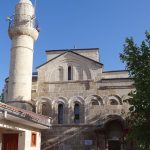“Top of the Roads” Population: 1,000
Old names: İlisra (?), Yeşiltepe
Heading south from Konya to Karaman you’ll probably sweep straight past the small settlement of Yollarbaşı to the south of the road just before you reach Karaman. With time on your hands it’s worth a quick diversion to visit the Ulu (Büyük) Cami, an unexpectedly beautiful wooden mosque in the centre of the older part of the village.
The Ulu Cami was built in 1235 and externally it’s a relatively austere stone building with no minaret. However, the wooden porch hints at hidden glories since it’s supported by wooden columns topped with stalactite-carved capitals like those in the Ulu Cami at Afyon. Look more closely and you’ll see that the columns stand on marble bases obviously taken from a lost older building, probably a church to judge from the other stones reused as gateposts and as bases for the şadırvan (ablutions fountain).
Inside, the mosque passes through an annexe with a lovely carved mihrab and through beautifully carved inlaid wooden doors into the main mosque where 18 wooden columns – basically just varnished tree trunks – support a ceiling of many, many more tree trunks. There’s another fine carved mihrab with a few surviving turquoise tiles. But the most striking feature of the mosque is the huge platform provided for the muezzin and accessible via a ladder. Why it was so large is a mystery even allowing for the fact that Yollarbaşı was once much bigger than it is now. The gallery at the back of the mosque is also entirely built of wood. This part of the mosque is called a Cumalık, meaning that it’s used for Friday prayers, while the annexe is used at other times.
There are said to be church ruins in the town but I didn’t have time to look for them. Nor did I see the Pelitaltı Çami which was apparently built in 1078 and is also supported by tree-trunk columns.
Transport info
There are limited minibus services to Yollarbaşı although it’s probably easier to take a taxi from the centre of Karaman (18km).

